The Five Dynasties and Ten Kingdoms that followed the downfall of Tang Dynasty was a period of chaos and upheaval. Eventually, the northeastern part of China largely fall under the dominion of Khitan Liao Dynasty, while various kingdoms of China proper eventually unified under Song Dynasty, very much like Northern and Southern Dynasties period.
Most of the recognisable designs and aesthetics of Chinese shield, such as painted-on tiger or dragon head motif, lack of shield boss, and strong preference of round and pentagonal shields, as well as free-standing shields, became firmly established during this period. While new shields continued to be introduced, they no longer deviate significantly from the established norms.
Song Dynasty (960 AD – 1279 AD)
Must like its Southern Dynasties predecessors, Song Dynasty faced constant threat from several enemies with overwhelming cavalry superiority, namely Khitans, Jurchens and Mongols, as well as Tanguts to a lesser extent. However, Song Dynasty's attempts to emulate the combined arms force of its predecessors had largely failed due to several factors, chief among them the prohibitive cost, as well as the lost of technical knowledge of military-grade wagon crafting (due to the fact that exceedingly powerful Tang cavalry made war wagon obsolete and its knowledge forgotten).
 |
| A heavily deteriorated mural found in an ancient tomb at Xinhua county, depicting an armoured soldier with an enormous shield. Based on the coinage found inside the tomb, it is believed to date to late Northern Song period. |
As such, Song Dynasty was forced to adopt a passive defensive strategy. Song army had few cavalry and was heavily reliant on its crossbowmen, so it was only natural that free-standing shield became the dominant shield type during this period.
It should be noted that rattan shield began to appear in written records during Song period, although it had yet to be adopted en masse by the Chinese army.
Free-standing pentagonal shield/Bu Bing Pang Pai (步兵旁牌) and Li Pai (立牌)
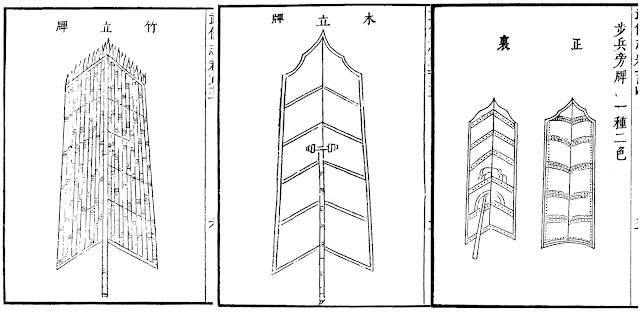 |
| Various types of free-standing infantry shields, from 'Wu Bei Zhi (《武備志》)'. |
This type of shield was made of either wooden planks or thick bamboo rods, bound together with cowhide thongs. It was pentagonal in shape, with a V-shape sloped surface for better deflection. It measured roughly 61 inches (~155 cm) in height, and 37 inches (~94 cm) in width, and came equipped with a 37 inches prop.
Li Pai and Bu Bing Pang Pai only differed in size and purpose but not in shape and construction. Li Pai was generally used in siege/siege defence, while Bu Bing Pang Pai was used for field battle.
Round cavalry shield/Qi Bing Pang Pai (騎兵旁牌)
 |
| Drawing of a Qi Bing Pang Pai, from 'Wu Bei Zhi (《武備志》)'. |
Song period cavalry shield was made of wood, presumably with leather facing. Unlike round cavalry shields of most other cultures, Chinese cavalry shield was strapped to the arm, rather than centre-gripped. This was likely because reinless riding was rather common among Chinese cavalry, whose primary methods of warfare were horse archery, two-handed lance or polearm, and dismounted combat.
Pentagonal long shield
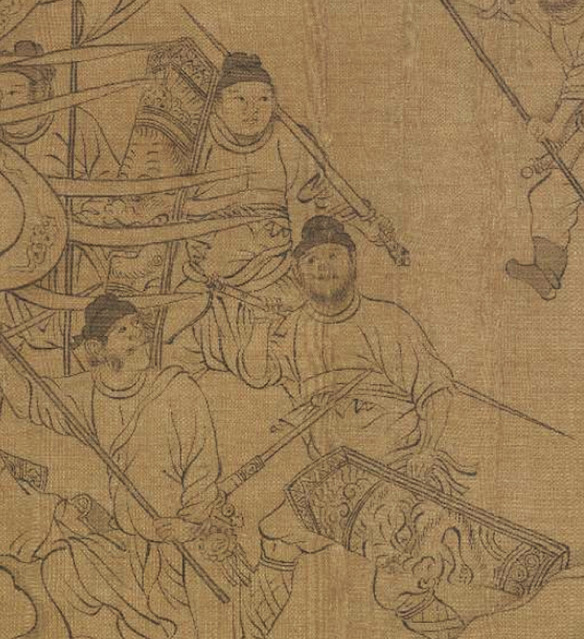 |
| Section of the scroll painting 'Xi Yue Jiang Lin Tu (《西嶽降靈圖》)' by famous Northern Song painter Li Gong Lin (李公麟), depicting two swordsmen armed with long shields. |
Yuan Dynasty (1271 AD – 1368 AD)
 |
| Section of the 13th century copy of Mōko Shūrai Ekotoba (《蒙古襲来絵詞 》), depicting Mongol troops (likely Korean auxiliaries) standing behind a row of rectangular shields. |
A new type of foldable shield, known as Die Dun (疊盾, lit. 'Stackable shield'), was developed during Yuan period, although no pictorial depiction of the shield survives to this day.
Ming Dynasty (1368 AD – 1644 AD)
After the overthrown of Yuan Dynasty, Chinese army returned to a somewhat more balanced, combined arms-oriented state. Traditional leather-faced wooden shield became the norm once again during early Ming period, only to be gradually superseded by nimbler and more protective wickerwork shield made of either willow (North China) or rattan (South China). Due to massive proliferation of firearms, Ming army as a whole became lighter armoured and more mobile, and this trend also reflected on shield design.
Free-standing shield/Ai Pai (挨牌)
 |
| Front (right) and back (left) view of an Ai Pai, from 'Ji Xiao Xin Shu (《紀效新書》)'. |
 |
| Front (right) and back (left) view of a rocket-armed shield, from 'Wu Bei Zhi (《武備志》)'. |
For more details on Ming Dynasty Ai Pai, see my other posts.
Handheld long shield/Shou Pai (手牌)
 |
| Drawing of a handheld shield, from 'Wu Bei Zhi (《武備志》)'. |
Shou Pai was essentially handheld version of Ai Pai. It came in pretty much the same variety of shapes as Ai Pai, although long pentagon and swallowtail shape were the most common. Unlike centre-gripped long shields of earlier dynasties, Ming period Shou Pai was vertically strapped.
It should be noted that some Ai Pai could be used as both free-standing shield and handheld shield, blurring the distinction between the two.
 |
| Section of scroll painting 'Wakō-zukan (《倭寇図巻》)', depicting Ming swordsmen armed with pentagonal long shields. |
Swallowtail shield/Yan Wei Pai (燕尾牌)
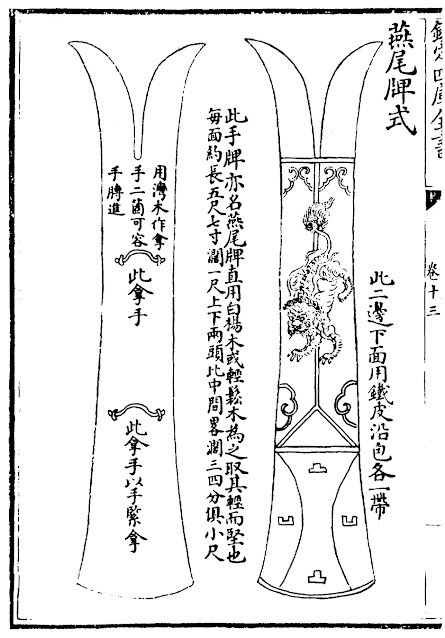 |
| Front (right) and back (left) view of a Yan Wei Pai, from 'Chou Hai Tu Bian (《籌海圖編》)'. |
A subtype of Ming handheld shield, Yan Wei Pai was a slender and agile shield with a characteristic swallowtail shape. It was the preferred shield of Lang Bing (狼兵), ethnic minority auxiliaries under Ming employment, and was probably introduced by them into the Ming army.
For more details on Ming Dynasty Yan Wei Pai, see my other post.
For more details on Ming Dynasty Yan Wei Pai, see my other post.
Round cavalry shield/Qi Bing Pang Pai (騎兵旁牌)
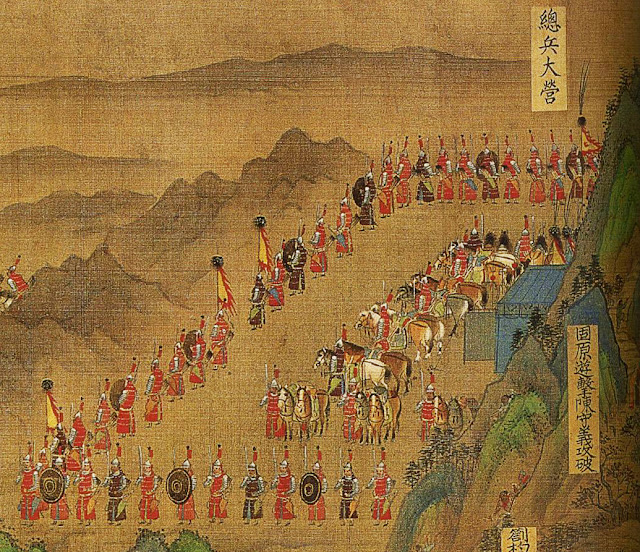 |
| Section of the scroll painting ‘Ping Fan De Sheng Tu (《平番得勝圖》)’, depicting dismounted Ming cavalrymen in a square formation, bearing round shields. |
Rattan shield/Teng Pai (藤牌)
 |
| Drawing of a rattan shield, from 'Ji Xiao Xin Shu (《纪效新书》)'. |
For more details on Ming Dynasty Teng Pai, see my other post.
Qing Dynasty (1644 AD – 1912 AD)
After the demise of Ming Dynasty, China once again fell under the rule of foreign conquerors. The Great Qing empire, last imperial dynasty of China, restructured its military into two organisations: the elite and prestigious Ba Qi (八旗, Eight Banners) made up of Manchus, Mongols, and some Han Chinese, as well as the more numerous, Han-majority Lu Ying (綠營, Green Standard Army) made up of various absorbed elements of former Ming military. Most forms of Ming shield designs, save one, were preserved in the arsenal of Lu Ying. Nevertheless, shield already became hopelessly obsolete in this age of gunpowder, and was well on its way out.Large infantry shield/Ai Pai
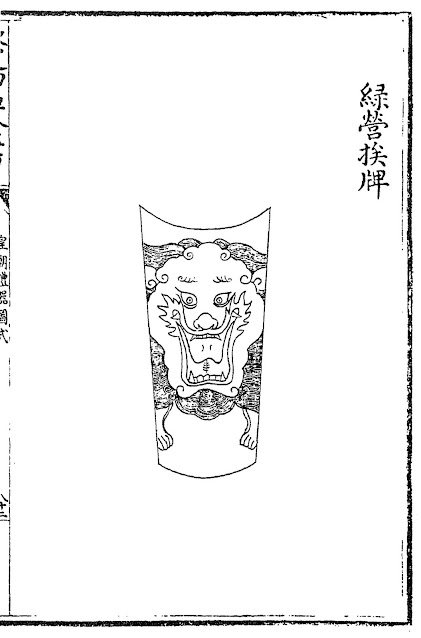 |
| Drawing of a Lu Ying Ai Pai, from 'Huang Chao Li Qi Tu Shi (《皇朝禮器圖式》)'. |
Lu Ying Ai Pai was a massive wooden shield with a concave top, measuring roughly 80.6 inches (~204.8 cm) in height and roughly 30.2 inches (~76.8 cm) wide at the top and 23 inches (~57.6 cm) wide at the bottom. The shield was designed to be strapped vertically to the arm by means of cords.
Trapezoid hand shield/Dun (盾) and Hu Tou Pai (虎头牌)
 |
| Hu Tou Pai (left) and Dun (right), from 'Huang Chao Li Qi Tu Shi (《皇朝禮器圖式》)'. |
Lu Ying Dun (盾, shield) and Hu Tou Pai (虎頭牌, lit. 'Tiger head shield') were two nearly identical shields, only differed slightly in size, shield decoration and the fact that Hu Tou Pai had leather facing. Both shields were essentially downsized version of Ming Dynasty Shou Pai.
Dun measured 32.6 inches (~83 cm) in height, 20.2 inches (~51.2 cm) at the top and 16.4 inches (~41.6 cm) at the bottom, while Hu Tou Pai measured roughly 36.5 inches (~92.8 cm) in height, 18.9 inches (~48 cm) at the top and 13.8 inches (~35.2 cm) at the bottom. Both shields were of strapped construction, utilising rattan cords as straps.
Dun measured 32.6 inches (~83 cm) in height, 20.2 inches (~51.2 cm) at the top and 16.4 inches (~41.6 cm) at the bottom, while Hu Tou Pai measured roughly 36.5 inches (~92.8 cm) in height, 18.9 inches (~48 cm) at the top and 13.8 inches (~35.2 cm) at the bottom. Both shields were of strapped construction, utilising rattan cords as straps.
Swallowtail shield/Yan Wei Pai
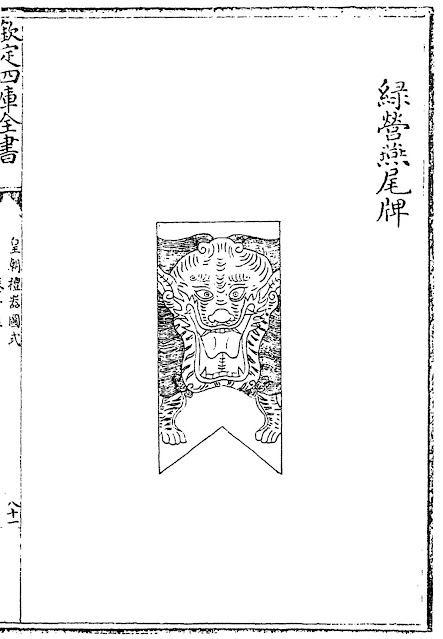 |
| Drawing of a Yan Wei Pai, from 'Huang Chao Li Qi Tu Shi (《皇朝禮器圖式》)'. |
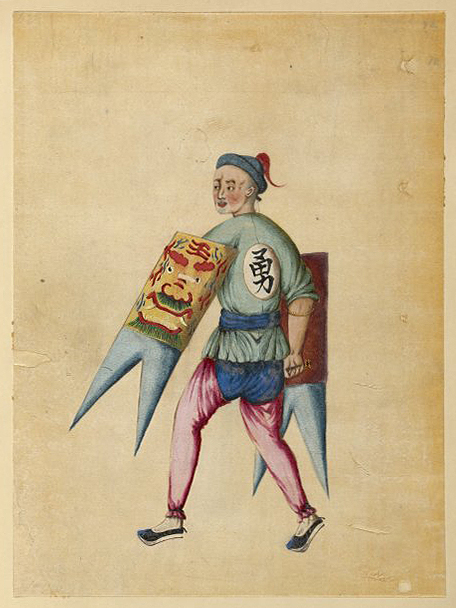 |
| Late Qing period export art depicting a militiaman wielding two Yan Wei Pai. Source: The New York Public Library Digital Collections. |
Round wooden shield
 |
| Drawing of a Yuan Mu Pai, from 'Huang Chao Li Qi Tu Shi (《皇朝禮器圖式》)'. |
Qing period round shield was also smaller than round shields of previous dynasties. It only measured 26.4 inches (67.2 cm) in diameter.
Rattan shield/Teng Pai
 |
| Drawing of a Teng Pai, from 'Huang Chao Li Qi Tu Shi (《皇朝禮器圖式》)'. |
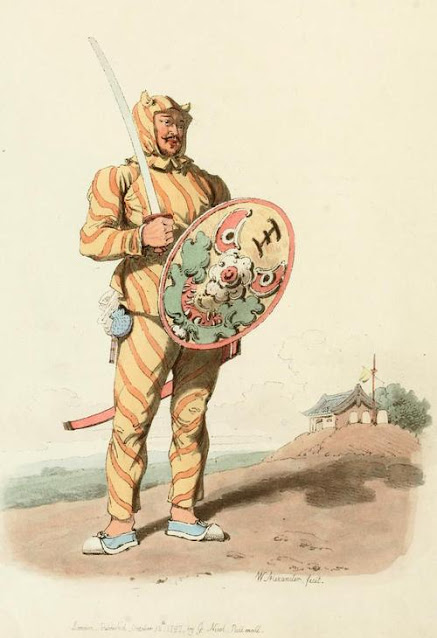 |
| Western depiction of a Tiger of War, from 'Costume of China', by William Alexander. |
Teng Pai was one of the few Chinese military equipment (apart from firearms) to be intentionally adopted by the elite Ba Qi army. In fact, an elite corps of ex-Koxinga rattan shieldmen went on and become one of the feared special forces of the Qing army. They later came to be known as "Tiger soldiers" or "Tigers of War" by Western observers due to their distinctive uniforms.
 |
| The last Patreon exclusive blog post is finally up! If you like this blog post, please also support my work at Patreon! |
Other blog posts in my Shield Evolution series:
Part 3: Song to Qing
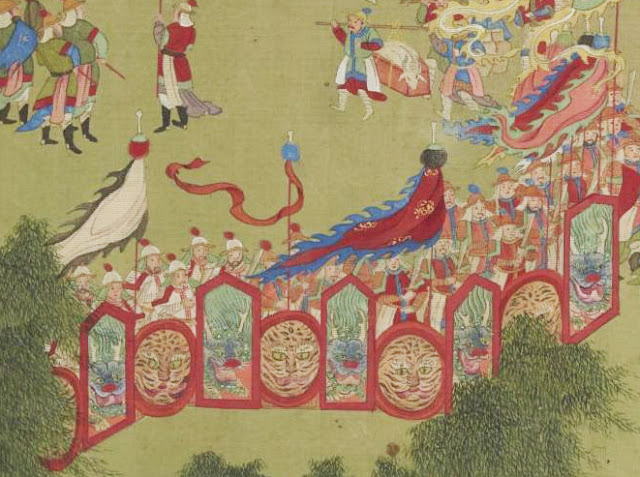
As a side note: there is always focus on a dominant side of militaries:
ReplyDeletefor example, Song infantry, Jin/Liao heavy cavalry, and so on.
But, say, Liao and Jin infantry? Independent extension of Northern Song tendencies opposed to something fresh, like it happened, say, in art? Or just southern Song infantry's poorer cousin, suddenly finding itself neglected? Or something else?
Same question with other Chinese/closely related areas, say, Dali. Their situation wasn't exactly the same until Mongol invasion...
The non-dominants tend to be neglected because they didn't left much of anything for me to cover.
DeleteJin Dynasty and Dali Kingdom will be covered in the upcoming Patreon-only part 4 though, even then, there isn't much.
It wasn't personal attack against you, please don't missunderstand.
DeleteIt's rather kind of outcry.
Liao and especially Jin were entities with huge pools of sendantary population, with routine usage of chinese infantry(or mounted infantry? or?), and it's staggering how little there is in english sector of internet about their part of the story.
On the other hand, my chinese still has a looong way to go to freely navigate on my own
No offense taken, don't worry =)
DeleteFor steel shields (personal or pavise)...how common were they?
ReplyDeleteI don't think Chinese used metal pavise (usually they mounted something that heavy on wheels). The Japanese had it though, probably for siege.
DeleteMetal personal shield was moderately common in North China (where Mongol influence was stronger). Thant is to say, I don't really know - the few Ming period shields discovered are all metal shields, since wooden shield perishes rather quickly.
You wouldn't happen to have any links to images of these surviving metal Ming period shields would you? Searching around myself, I've only been able to find rattan Tengpai when searching for Chinese shields and no metal ones.
DeleteActually I do, although the shields are left in a undisturbed state and thus look terrible.
Deletehttps://i.imgur.com/EznGYel.jpg
is there any place in China that skill teachers the use of sword/spear and shield, I like the designs shown in all these parts curious to know if any of them are still practice with.
ReplyDeleteNo spear and shield AFAIK. For sword and shield, only martial arts for rattan shield survive in various forms/schools/dances (because it was the most common shield type in China for the past 2 ~ 5 centuries). Most of the surviving ones are more like performance arts than serious martial skills though, and even the serious ones no longer seriously spar anymore.
DeleteWell that's a real shame thanks for the answer, hey this is not really relevant to the article but I was wondering if perhaps you could recommend some Chinese war movies, I watch The Art of War on Netflix it was pretty entertaining I kind of want to watch some more movies like it if you don't mind.
DeleteSorry I meant God of War.
DeleteUnfortunately most Chinese war movies are pretty bad...
DeleteBattle of Wits (2006) was a good one even though it's not very historically accurate. But it's probably the only movie that introduces Mohism and have interesting battle tactics. Not much martial arts in it but it's very well-done IMO
DeleteRed Cliff (2008) is alright if you enjoy big battles and strategies taken out of the Romance of the Three Kingdom. Nothing thought-provoking though, basically a big budget, bro-mance action movie
Saving General Yang (2013) - it's not a perfect film but if you enjoy somewhat grounded martial arts in battlefield setting against overwhelming odds then this is for you. Based on the Yang Family Generals legend, not so much history.
The Warlords (2007) - is a good drama/action. Set in Qing period with firearms thrown in. Very gritty and brutal. No "good guys" really.
https://www.youtube.com/watch?v=-KzpTLZ_e40
DeleteNot a movie, but a great rattan shield demo(I'd skip halfway into the video if you already know the history). Maybe some HCMA ppl can rehabilitate some of these martial arts.
The Fall of Ming is not too bad.
DeleteI know that in Hasayfu and Choy li fut kung fu the tiger head shields are used. According to the discription in the article I would say look a lot like the yan wei pah. They are listed on https://plumblossom.net/ChoyLiFut/formslist.html (and if you click on 53 weapons in the left collomn it is listed at number 44). In the form list under the 2 part weapons section it is listed as Double Tiger's Head Shields (Seung Fu Tau Pah) 双虎頭牌 (below Broadsword and Chain-Whip (Dahn Do Bin) 单刀鞭 and above Double Rattan Shields (Seung Tang Pah Dip) 双籐牌碟)
DeleteIt is also listed in the two persons weapons combat forms section as Tiger's Head Shield and Broadsword vs. Kwan-Do (Dahn Do Fu Tau Pai Dwei Chuck Kwan-Do) 单刀虎頭牌對拆関刀
The edges and tips of these Tiger head shields are sharp and are used to also attack with, so I don't know if these are the same as the ones in this article, maybe the admin can help you with that. (I'm actually also very interested in the answer as the oldest date I have found so far for these shields is around 1830 (it's really hard to do an online search and get results the date is more related to when Choy Li Fut was created) and I want to show some other people that said that duel wielding shields was dumb, impractical and never done that they are wrong and having good dates and reference material is rather useful)
You said wanted to learn it in China right?, well I'm sure that you could learn Choy Li Fut around Guangzhou, but they also have schools around the world and perhaps 1 near you. You can look for their Choy Li Fut schools by country on the same website. Good Luck XD
@Jugglejunk
DeleteGood day and welcome to my blog. Thanks for your imput, I wasn't aware such an art still exist in Hasayfu and Choi Li Fut.
I checked up some training demostration videos with two shields and descriptions on some Choy Li Fut sites, and I think the resemblence to Qing-style Yan Wei Pai is very clear. 《皇朝禮器圖式》 was completed in 1759, so the history of Tiger's Head Shield can be pushed back at least that far.
how is yuanmupai written in chinese
ReplyDelete圓木牌
DeleteIs Recueil Historique des Principaux Traits de la Vie des Empereurs Chinois from the Ming dynasty? Because someone I know says it to be Quing ore maybe a copy of it.
ReplyDeleteYes, it is an early Qing reprint of a Ming book with better and coloured illustrations.
Deleteare they armed with super narrow jian in 西岳降臨圖?
ReplyDeleteNo? Chinese jian are not particularly broad to begin with. The illustrated jian has pretty strong tapering, but that may be artistic license.
Delete